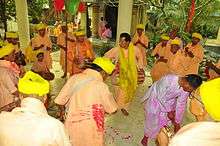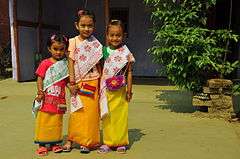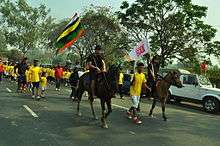Yaosang
Yaosang is a festival celebrated in Manipur for five days in spring, starting on the full moon day of the month of Lamda (February–March). Yaosang is indigenous traditions of the Meitei people.[1] It is considered the most important festival in Manipur.[2] Like Holi, the Hindu Meitei of Manipur play with colours during this festival.

| Yaoshang | |
|---|---|
 Perhaps kids in traditional attire going for Nakatheng is the most sought after sight during the Yaosang festival | |
| Observed by | Meitei people and other secular non-Meiteis. |
| Type | Manipuri religion |
| Celebrations | After firing the temporary house, people started to celebrate it with colors, sports, dance and feasts. |
| Date | as per Meitei calendar |
| Frequency | Annual |
Description
Yaosang begins just after sunset in every village with the Yaosang Mei thaba, or Burning of the Straw Hut. Then the children ask at every house for monetary donations, called nakatheng. On the second day, groups of local bands perform sankirtan in the Govindagee Temple in the Imphal-East district of Manipur. On the second and third days, girls go to their relatives for their nakatheng and block roads with ropes for collecting money. On the fourth and fifth days, people pour or splash water on one another.
Dance
Another feature of this festival is Thabal Chongba (Dancing in the Moonlight). Males from various places will come to the site of the festival and dance in circles with the females, holding their hands. In 2016, this occurred 23–24 March.[3]
Celebrations
The locals also engage in feasting to celebrate this festival of merrymaking. Of late, there has been a trend of channelling the festive energy toward sporting events to spot out talents at the grassroot level, which is in line with the rich sporting spirit of the Meiteis.
Gallery


References
- Sanajaoba, Naorem (1988). Manipur, Past and Present: The Heritage and Ordeals of a Civilization, Volume 4. New Delhi: Mittal Publications. ISBN 9788170998532.
- Singh, Ksh Imokanta (2008). Religion and Development in North-east India: A sociological understanding (PDF). Religions and Development Research Programme. University of Birmingham. p. 76. ISBN 0 7044 2655 2. Retrieved 18 June 2015.
However, rather than starting a completely new religious system, their efforts have focused on establishing a parallel culture to counter the Vaisnavite forces, for example observance of Yaosang (Meitei version of Holi) during the same period as the Hindu Dol jatra festival. This movement may try to create a political fissure within the society, but it is very difficult to sort out which elements are purely Hindu and which indigenous, because people have long internalized both elements in their way of life.
- Parratt, Saroj Nalini (April 1974). "The Public Festivals". The Religion of Manipur: Beliefs, Rituals and Historical Development (PDF) (Thesis). Australian National University. p. 43. Retrieved 18 June 2015.
The third, and most important, of the Krishnaite festivals is Dol Jatra, or, to give it its Meitei name, Yaosang. This is the greatest of the Meitei festivals and is celebrated on the full moon of Lamda (FebruaryMarch), lasting for six days.
- http://manipur.gov.in/wp-content/uploads/2013/02/general_holiday_2016.pdf